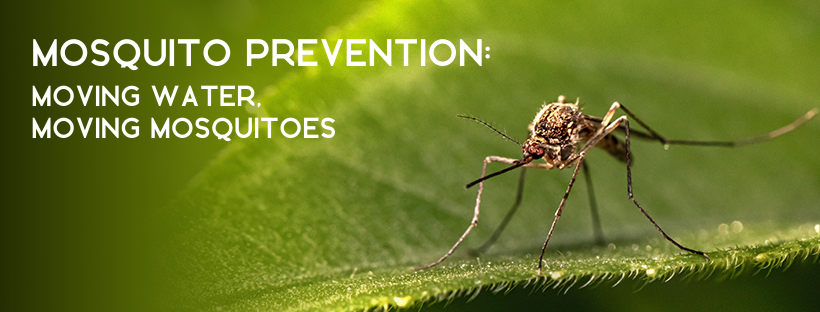Moving Water, Moving Mosquitoes
Some are drawn to the warmth and promise of spring, others, the cool colors of fall. Those that love the extremes of summer and winter are fewer, but no less dedicated. We are driven outdoors with varied purpose—falling snow, shining sun and sounds of nature. But one thing unites us all — our common dislike of the pesky mosquito.
These tiny organisms are more than annoying with a hefty bite. From yellow fever to malaria to zika, humanity has, time and again, waged a war against the mosquito. Know thy enemy. Mosquitoes are small flies that lay eggs in or on stagnant water. Once hatched, larvae live in water and feed on debris until reaching adulthood. Timeline from egg to adult? One week.

If that’s not enough to get you playing defense, this should—the mosquito is responsible for more human deaths than any other animal on earth, including humans. Just like other threats, there are clear strategies to adopt—and it starts with prevention. More specifically, it begins with water.
Take a good long look around your property. Anything that can hold water is suspect—cans, tarps, tires, birdbaths—even saucers that cradle flowerpots. Each a potential breeding ground for mosquito larvae. Remove, drain, fix—eliminate. Address the issue and check it off your list.
Remember…timeline from egg to adult is one week.
After a heavy rain, check if ditches dry up swiftly—puddles, too. Just the barest amount of water—one quarter of one inch—can play host to mosquito eggs.
One Easy Solution – Make Your Water Move!
In honor of June 3rd being Insect Repellent Awareness Day, we’re sharing one of the easiest and most organic ways to help protect your yard of mosquitoes.
Birdbaths and ponds serve as a breeding ground for mosquitoes only when the water is still, a requirement for mosquitos ready to lay eggs. When the water’s surface is broken, mosquitoes are unable to lay eggs, and they move on.
There is the good news. The organic solution is also the simplest—add an aerator (either a Typhoon Aeration Kit or an OASE AquaOxy 450) or a small fountain pump to your birdbath. Moving water will eliminate the mosquito threat. For larger bodies of water in your backyard, position a water pump on the floor of your pond to keep the water moving and break the breeding cycle.



Adding a simple, yet visually stunning, fountain to your pond or water garden, like the Filtral UVC, is an easy way to get your still water moving with the benefit of your choice of fountain nozzle options.
Atlantic-OASE’s long line of pond and water feature pumps are quiet and effective in creating efficient water movement in various sizes and bodies of water. Ensuring water circulation throughout a pond or water feature, pumps help to inhibit mosquito reproduction. High humidity. Spring thunderstorms. Piled-up snow. The outdoors provides challenges that can damper the experience. But mosquitos are more than a mild nuisance, they are a disease delivery system that can wreak havoc throughout communities and across countries. Difficult to control, impossible to eradicate, prevention is the only strategy that can be the sole difference.
Read more on the blog here!
About the Author:

Caitlyn Winkle
After graduating from the University of Akron, Caitlyn joined Atlantic-OASE in the fall of 2019. Caitlyn manages the social media and online content for the company. She also supports the Atlantic-OASE Professional Contractor (APC) Program and Marketing Departments in creating marketing and advertising strategies and plans.


